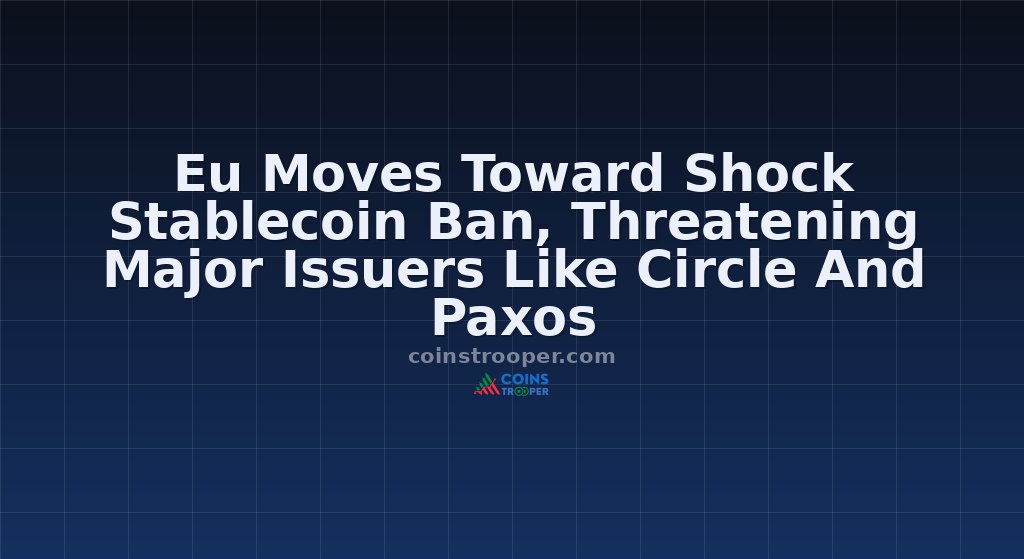Eu Moves Toward Shock Stablecoin Ban, Threatening Major Issuers Like Circle And Paxos

- At the center of the debate are so-called multi-issuance stablecoins, tokens jointly issued in the EU and abroad, but treated as interchangeable.
- Under this model, EU-licensed issuers must hold reserves within the bloc, while their non-EU partners continue to manage reserves for identical tokens overseas.
- Lagarde has repeatedly raised concerns that gaps in the EU’s Markets in Crypto-Assets Regulation (MiCA) leave the bloc exposed.
- The push reflects broader fears in Europe that dollar-denominated stablecoins could undermine the bloc’s financial sovereignty.
What Happened
According to a Bloomberg report, regulators warn that during a market downturn, investors would rush to redeem in the EU, overwhelming local reserves and exposing the bloc to liabilities from outside jurisdictions.
She stressed that unless strong equivalence regimes and safeguards for cross-border asset transfers are introduced, multi-issuance schemes will not be permitted to operate in the EU.
Circle and Paxos, both operating primarily out of the United States, are among the issuers most affected by the potential restrictions. Their reserves are largely invested in dollar cash and short-term U.S. government securities.
Cash to Stay as EU Prepares for 2029 Digital Euro Launch
Market Context
Lagarde has repeatedly raised concerns that gaps in the EU’s Markets in Crypto-Assets Regulation (MiCA) leave the bloc exposed.
Speaking at an ESRB conference, she argued that joint issuance without stricter oversight of non-EU entities creates systemic risks similar to cross-border banking crises, where liquidity mismatches and inadequate reserves once destabilized financial systems.
Euro-backed tokens currently represent just 0.15% of the $230 billion global stablecoin market, while USD-pegged assets dominate with a 99% market share.
Why It Matters
The European Central Bank (ECB) has gained backing for a sweeping stablecoin ban across the European Union (EU), a move that could disrupt major issuers such as Circle and Paxos.
ECB’s Lagarde Pushes Hard Line on Stablecoin Models Seen as Financial Risk
The European Systemic Risk Board (ESRB), a high-level group of central bank governors and EU officials chaired by ECB President Christine Lagarde, endorsed a recommendation last week to ban such models, according to people familiar with the matter.
The push reflects broader fears in Europe that dollar-denominated stablecoins could undermine the bloc’s financial sovereignty.
ECB adviser Jürgen Schaaf has previously warned that growing reliance on dollar stablecoins could weaken the effectiveness of European monetary policy.
Regulators in Finland and France, which oversee the firms’ EU operations, declined to comment on the potential implications of the proposal.
A paper published this month by Bank of Spain board member Judith Arnal warned that disagreements between the ECB, the Commission, and the European Parliament risk undermining MiCA’s credibility as a global standard.
Details
At the center of the debate are so-called multi-issuance stablecoins, tokens jointly issued in the EU and abroad, but treated as interchangeable.
Under this model, EU-licensed issuers must hold reserves within the bloc, while their non-EU partners continue to manage reserves for identical tokens overseas.
While the guidance is not legally binding, it adds pressure on EU authorities to either adopt the restrictions or explain how they would otherwise safeguard financial stability. Both the ECB and the ESRB declined to comment.
Spokespeople for Circle and Paxos also declined to comment, though people familiar with their position noted that the European Commission had previously been supportive of the multi-issuance model.
The European Commission itself has yet to adopt an official stance, and divisions remain within EU institutions. While the ECB has pressed for a hard line, some policymakers favor clearer safeguards over an outright ban.
The move comes as Europe debates the development of a digital euro, which the ECB began pushing in 2021 and still awaits legislative approval.
Officials in Frankfurt argue that the rise of dollar-backed stablecoins shows the urgency of securing a European alternative.
The ECB is balancing tradition and new approaches as it advances work on both cash and digital currencies, while European lenders prepare their own euro-backed stablecoin.
In August, ECB Executive Board member Piero Cipollone reaffirmed that physical euro banknotes remain indispensable despite the rapid rise of digital transactions.
In a blog post, he argued that cash would coexist with the planned digital euro, describing the system as a “dual payment future.” Over €1.6 trillion in euro banknotes are in circulation, and demand continues to grow, particularly in times of crisis.

